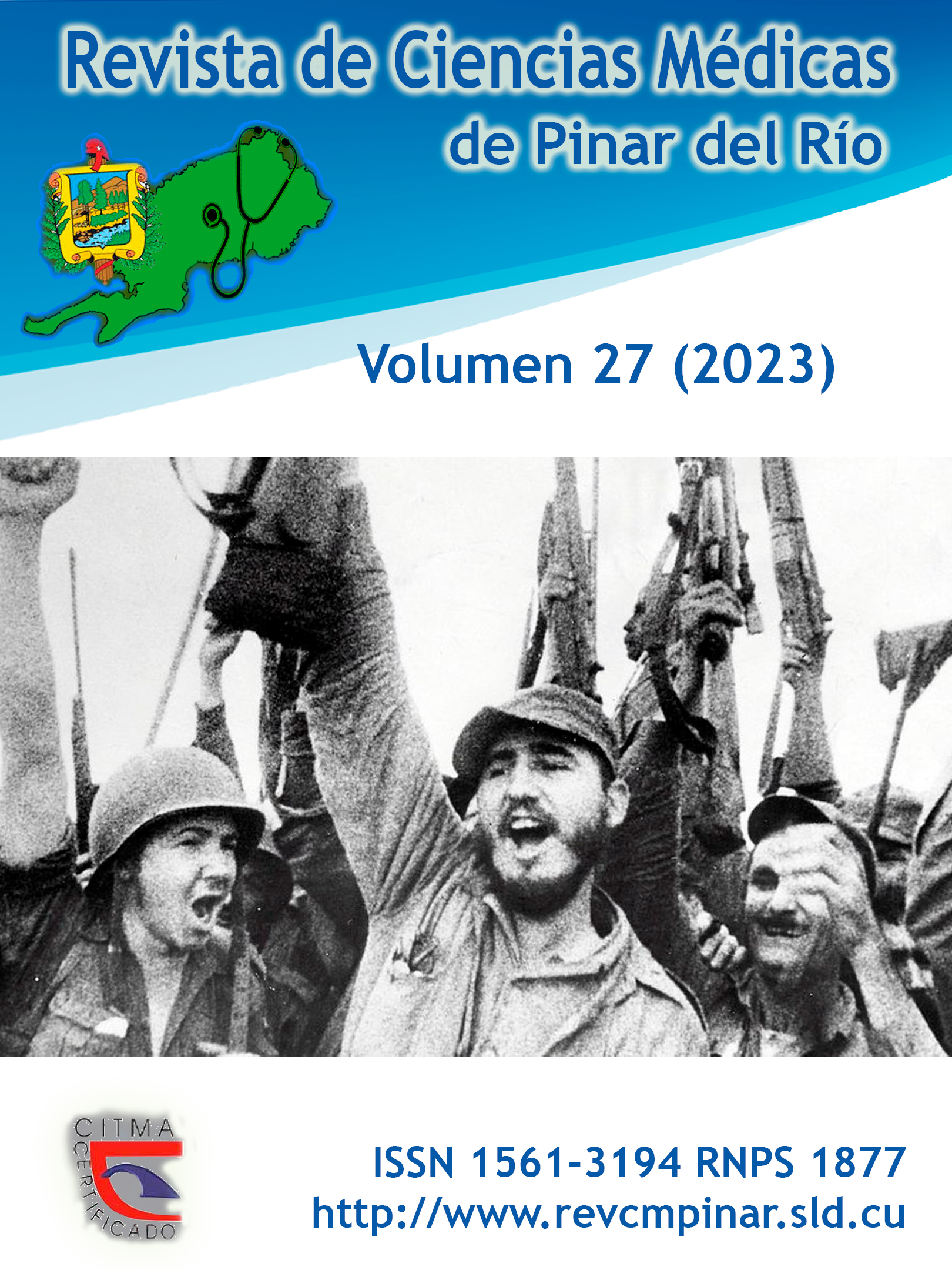Effectiveness of exodontia with acupuncture analgesia
Keywords:
ACUPUNCTURE ANALGESIA, SURGERY, ORAL, ANESTHESIA.Abstract
Introduction: exodontia is that part of oral surgery that deals with the extraction of a tooth or portion of it, by means of techniques and appropriate instruments from the bone bed that houses it. The application of acupuncture surgical analgesia is an effective option for stomatologists to perform this treatment due to the advantages it offers.
Objective: to determine the effectiveness of exodontia performed with acupuncture surgical analgesia.
Method: a quasi-experimental study was carried out at the Francisco Peña University Polyclinic of the Nuevitas municipality between January 2019 and January 2020. The universe was constituted by 73 patients who needed an exodontia as stomatological treatment and a sample of 46 patients was selected by the simple random method. Theoretical, empirical and statistical-mathematical methods were used.
Results: female sex predominated and the most frequent age group was 46 to 55 years old. Transoperative pain intensity in both jaws ranged from absent to mild, with only one case of moderate pain. The optimal time for acupuncture analgesia was shorter in the maxilla than in the mandible. No adverse reactions were reported in the patients treated.
Conclusions: surgical acupuncture analgesia is a procedure with scientific basis in continuous. development. Its indication for exodontia in stomatology is an, economical effective, safe and innocuous method.
Downloads
References
1. Rivero Pérez O. Cirugía Bucal. Selección de temas. La Habana: Editorial Ciencias Médicas; 2018.
2. Murillo Alemán TM. Técnicas y formas utilizadas para la extracción de dientes permanentes en el maxilar superior e inferior [Trabajo de grado]. Guayaquil, Ecuador: Universidad de Guayaquil Facultad Piloto de Odontología; 2015 [citado 13/01/2021]. 36p. Disponible en: http://repositorio.ug.edu.ec/handle/redug/17762
3. Plain Pazos C, Pérez de Alejo PA, Rivero Viera Y. La Medicina Natural y Tradicional como tratamiento alternativo de múltiples enfermedades. Revista Cubana de Medicina General Integral [Internet]. 2019 [citado 13/01/2021]; 35(2): 1-18. Disponible en: https://www.medigraphic.com/cgi-bin/new/resumen.cgi?IDARTICULO=94434
4. Góngora Gómez O, Sarmiento Peña Y, Gámez Leyva LR, Gómez Vázquez YE. Técnicas de la Medicina Natural y Tradicional utilizadas en el tratamiento de la es¬tomatitis subprótesis. Inmedsur [Internet]. 2020 [citado 13/01/2021]; 3(1): 53-58. Disponible en: http://www.inmedsur.cfg.sld.cu/index.php/inmedsur/article/view/61
5. Pita Laborí LY, Tabera García ME, Matos Cantillo D, Thomas Ferrer F, Thomas Ferrer A. Beneficios, contraindicaciones y precauciones de la Medicina Natural y Tradicional como respuesta a los problemas de salud estomatológicos. RIC [Internet]. 2017 [citado 13/01/2021]; 96(2): 314‐324. Disponible en: https://www.medigraphic.com/cgi-bin/new/resumen.cgi?IDARTICULO=73499
6. Sánchez Valdeolla OE. Particularidades de empleo de la medicina natural y tradicional en los cinco continentes. Revista Cubana de Medicina Natural y Tradicional [Internet]. 2020 [citado 13/01/2021]; 3. Disponible en: http://revmnt.sld.cu/index.php/rmnt/article/view/107
7. Cuba. Ministerio de Salud Pública. Programa para el desarrollo y la generalización de la medicina tradicional y natural. La Habana: MINSAP; 2011.
8. Perdomo Delgado J, González Pla EA, Avello Romero L, Beltrán Delgado M, Carrero Figueroa MV. Principales resultados del Programa de Medicina Natural y Tradicional en Cuba (2018-2019). Revista Cubana de Medicina Natural y Tradicional [Internet]. 2020 [citado 13/01/2021]; 3. Disponible en: http://www.revmnt.sld.cu/index.php/rmnt/article/view/163
9. Ramos Portuondo H, Arias Chacón M, de la Fé Batista L, Ogra Álvarez MC. Analgesia acupuntural en la actividad quirúrgica. Realidad práctica alternativa. Rev Pol Con [Internet]. 2017 [citado 13/01/2021]; 2(3): 3-18. Disponible en: https://pdfs.semanticscholar.org/d386/763ae47e32aab910d41da019abe8373d3c08.pdf
10. Tápanes Nieves Y, Martínez Ortiz LA. Bondades de la analgesia acupuntural en procederes de estomatología. Archivo del Hospital Universitario “General Calixto García”. [Internet]. 2018 [citado 13/01/2021]; 6(1): 71-77. Disponible en: http://revcalixto.sld.cu/index.php/ahcg/article/view/251
11. Naranjo Zambrano YJ. Importancia de la anestesia acupuntural [Trabajo de investigación]. Bogotá, Colombia: Universidad Nacional de Colombia Facultad de Medicina; 2017 [citado 13/01/2021]. 45p. Disponible en: https://repositorio.unal.edu.co/handle/unal/59534
12. Abarca Zúñiga M, Hernández Solórzano L, Leandro Ureña F, Montero Jiménez N, Salas Rojas J. Uso de analgesia acupuntural en las extracciones dentarias: revisión de literatura. Revista iDental [Internet]. 2020 [citado 13/01/2021]; 12(1): [aprox.11p.]. Disponible en: http://www.idental.periodikos.com.br/article/5fe3a1d20e8825680212bf19
13. Abreu Correa JM, Mateo JE. Analgesia acupuntural en las extracciones dentarias. Rev Cubana Estomatol [Internet]. 1997 [citado 15/10/2018]; 34(2): 110. Disponible en: Disponible en: http://scielo.sld.cu/scielo.php?script=sci_arttext&pid=S0034-75071997000200011&lng=es
14. Vistel Montoya D, Solano Pérez M, González Moreno E, Maldonado Chávez M. Efectividad de la analgesia quirúrgica acupuntural en pacientes operados de catarata. MEDISAN [Internet]. 2020 [citado 13/01/2021]; 24(1): 16-28. Disponible en: scielo.sld.cu/scielo.php?pid=S1029-30192020000100016&script=sci_arttext&tlng=en
15. Capote Hernández AZ, Alonso Menéndez HC, González Rodríguez SI. Efectividad de la analgesia quirúrgica acupuntural en operaciones de hernia inguinal tipos I y II. Revista Cubana de Medicina Natural y Tradicional [Internet]. 2020 [citado 13/01/2021]; 3. Disponible en: http://revmnt.sld.cu/index.php/rmnt/article/view/154
Downloads
Published
How to Cite
Issue
Section
License
Authors who have publications with this journal agree to the following terms: Authors will retain their copyrights and grant the journal the right of first publication of their work, which will be publication of their work, which will be simultaneously subject to the Creative Commons Attribution License (CC-BY-NC 4.0) that allows third parties to share the work as long as its author and first publication in this journal are indicated.
Authors may adopt other non-exclusive license agreements for distribution of the published version of the work (e.g.: deposit it in an institutional telematic archive or publish it in a volume). Likewise, and according to the recommendations of the Medical Sciences Editorial (ECIMED), authors must declare in each article their contribution according to the CRediT taxonomy (contributor roles). This taxonomy includes 14 roles, which can be used to represent the tasks typically performed by contributors in scientific academic production. It should be consulted in monograph) whenever initial publication in this journal is indicated. Authors are allowed and encouraged to disseminate their work through the Internet (e.g., in institutional telematic archives or on their web page) before and during the submission process, which may produce interesting exchanges and increase citations of the published work. (See The effect of open access). https://casrai.org/credit/



